What Is a Stylophone? The Pocket Synth That Changed Music
What is a Stylophone? It’s a mini, pocket sized analog synthesizer first created in 1968 by British engineer Brian Jarvis at his company Dubreq. Unlike traditional keyboards, it uses a metal stylus that touches a printed circuit board laid out like piano keys, producing a thin, buzzing retro synthesizer sound.
The Stylophone wasn’t just a novelty. By the mid 70s, millions had been sold worldwide, making it one of the most successful portable music instruments ever produced. Its quirky tone even caught the ear of artists like David Bowie, who famously used it in Space Oddity.
In this article, you’ll discover what is a Stylophone, how the Stylophone works, why it was invented, its signature features, its influence on musicians, and how modern versions like the Stylophone Gen X-1/Gen X-2 and Stylophone Gen R-8 continue its legacy as an iconic electronic keyboard.
What Is a Stylophone and How Does It Work?

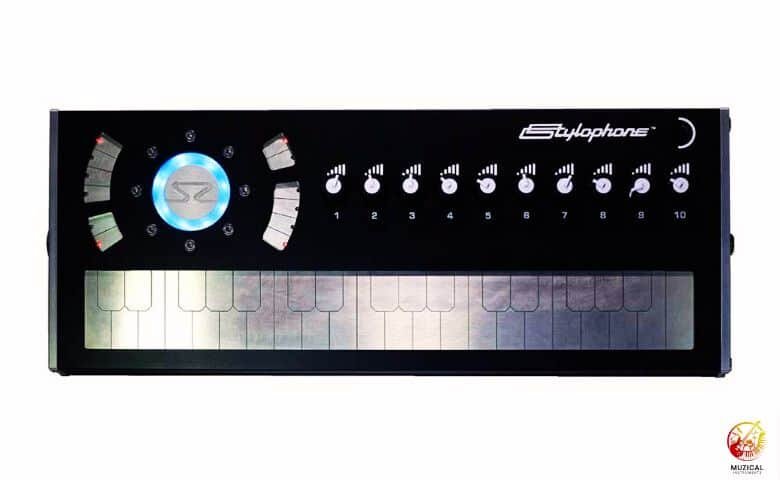
A Stylophone is a marvel of simplicity and clever design. Invented by Brian Jarvis at Dubreq Studios in London in 1968. It’s a small, rectangular plastic casing, roughly the size of a modern smartphone, but a bit thicker.
At its core, the Stylophone is a stylus operated keyboard. You hold a small metal pen and tap it against the metallic surface of the printed circuit board. Each note completes a circuit, generating the Stylophone’s signature sound: a thin, buzzing, distinctly retro electronic tone from its analog oscillator.
The instrument originally had only three controls: a power switch, a tuning knob, and a vibrato button. The sound comes through a small built-in speaker, though it can also connect to an external amplifier or headphones.
Its buzzing, electronic tone is unlike a piano or guitar. That uniqueness is exactly why many musicians love it, it cuts through a mix with a nostalgic, lo-fi charm.
Pro Tip: Try running a Stylophone through effects pedals. Adding delay or distortion transforms it from a quirky toy into a versatile tool for sound design.
Why Was the Stylophone Invented?
In the late 1960s, most synthesizers were bulky, expensive machines found only in recording studios. Brian Jarvis wanted to change that. His idea was to design a cheap, battery powered organ substitute that anyone could carry and play.
The first Stylophone launched in 1968 through Dubreq Studios in London. Its affordability and novelty made it an instant success. By offering a pocket synth at a fraction of the cost of larger instruments, Jarvis opened the door for everyday people to explore electronic music.
By 1975, millions of units had been sold, making it one of the best selling musical gadgets of all time. For many people, the Stylophone was their first encounter with a synthesizer, long before digital pianos and MIDI keyboards became common.
Expert Insight: The Stylophone foreshadowed today’s portable synthesizers and music apps. It proved that electronic instruments didn’t have to be intimidating or expensive.
What Are the Key Features of a Stylophone?
The Stylophone may look simple, but its design explains why it became iconic.
| Feature | Description | Benefit |
|---|---|---|
| Stylus-Operated Keyboard | A metal strip acts as the keyboard; notes are played by touching it with a special metal stylus. | Intuitive and unique playing method, no complex fingerwork required. |
| Analog Sound | Produces a distinctive, thin, buzzing, retro electronic tone generated by analog circuitry. | Signature sound, often described as nostalgic or quirky. |
| Miniature & Portable | Compact, handheld size, and battery-powered (usually AA batteries). | Easily carried anywhere, ideal for on-the-go music making. |
| Simple Controls | Typically includes a power switch, vibrato (VBR) control, and a tuning knob. | Easy to learn and operate, minimal learning curve. |
| Built-in Speaker | Features a small integrated speaker for immediate audio playback. | All-in-one unit, no need for external amplification. |
These features made it both a toy instrument and a serious electronic music tool. Beginners loved its accessibility, while musicians valued its raw, analog sound for adding texture to recordings.
Who Made the Stylophone Famous?
The Stylophone’s leap from novelty gadget to music legend came thanks to David Bowie. In 1969, he used it on Space Oddity, cementing its association with futuristic, spacey music.
Other notable artists also adopted it:
- Kraftwerk, pioneers of electronic music, experimented with its tones.
- Pulp referenced it in their track Styloroc (Nites of Suburbia).
- Orbital included it in their live performances.
Its buzzing tone stood out in an era of guitars and drums. For experimental and avant garde musicians, the Stylophone became a tool for creating sounds that felt both playful and otherworldly.
Thought Question: Could the Stylophone be considered the first mainstream lo-fi instrument, long before lo-fi became a genre?
Which Stylophone Models Are Available Today?
The first wave of Stylophone popularity peaked in the 1970s. Production ceased around 1975 as demand slowed and newer instruments emerged.
But its story didn’t end. In 2007, the Stylophone was relaunched with modern models. These kept the original charm but added new features.
The classic Stylophone S1 brings back the original 1968 design with modern improvements. It keeps the essential analog sound while adding headphone outputs and better battery life. This version costs around $30 and gives you authentic vintage tones.
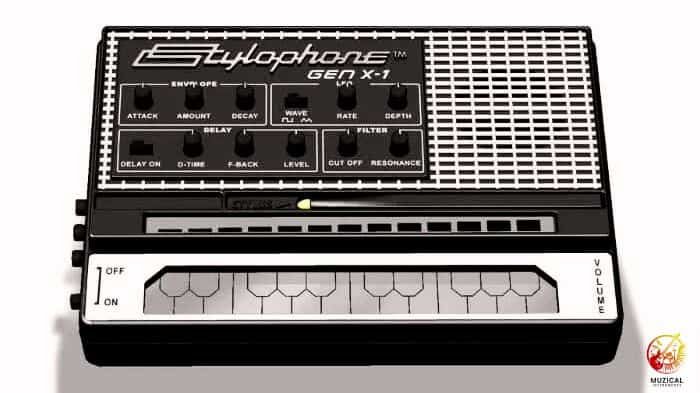
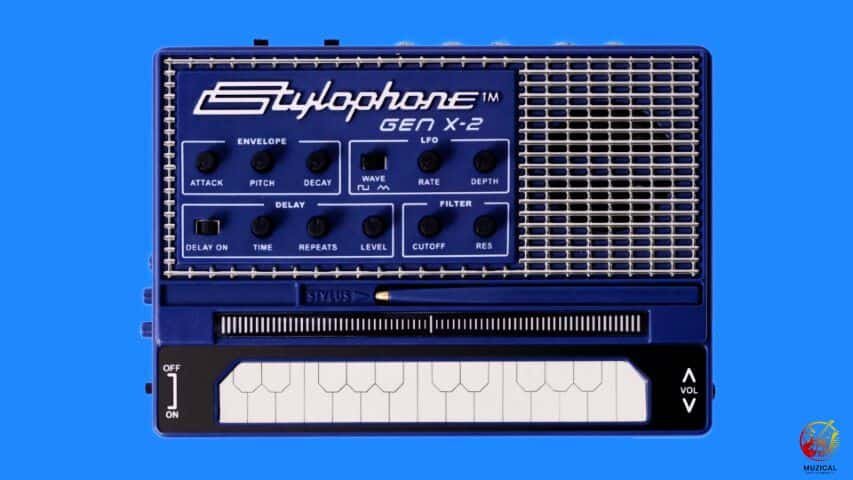
The Gen X-1/ Gen X-2 targets serious musicians and producers. Multiple waveforms, built-in delay effects, and expanded range make it suitable for professional recording. Electronic music artists love how it bridges vintage character with modern functionality.
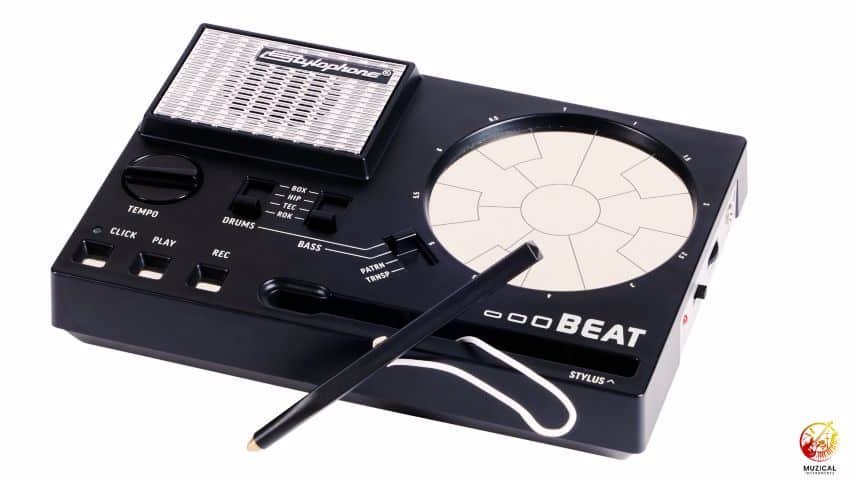
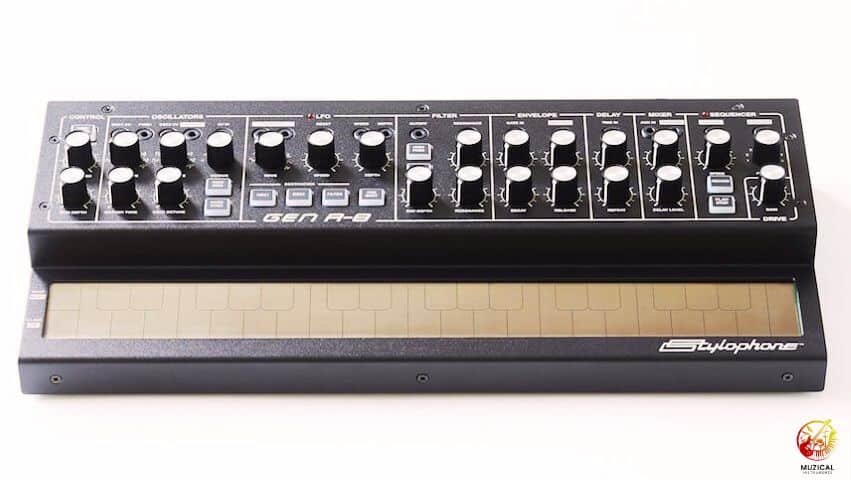
The Stylophone Beatbox is a pocket-sized electronic drum machine. You tap its metal surface with a stylus to create beats, voices, and sounds. It includes drums, percussion, and fun effects, making rhythm play simple and exciting for everyone.
The Gen R-8 adds rhythm capabilities and loop functions. You can layer beats under your melodies, turning the simple concept into a complete music making station. Hip-hop producers and beat makers find creative ways to use this expanded version.
Limited edition models appear regularly, often featuring collaborations with famous artists or unique visual designs. These special versions maintain standard functionality while appealing to collectors and enthusiasts.
| Model | Price Range | Best Features | Ideal For |
|---|---|---|---|
| Stylophone S1 | $25-35 | Classic analog sound, headphone out | Beginners, vintage enthusiasts |
| Gen X-1/Gen X-2 | $150-200 | Multiple waveforms, effects, expanded range | Recording, live performance |
| Gen R-8 | $200-300 | Rhythm section, loops, sampling | Beat making, electronic production |
Who Uses a Stylophone Today?
The Stylophone’s charm today reaches far and wide, across different ages and music styles. It’s no longer seen only as a fun little toy, it’s now respected as a real instrument with its own unique voice.
Here’s a look at its diverse user base:
| User Category | Description | Examples/Use Cases |
|---|---|---|
| Nostalgia Seekers | Individuals who remember the original Stylophone from their childhood or appreciate its retro charm. | Collectors, those seeking a tangible connection to vintage music, or simply for recreational play. |
| Electronic Musicians | Artists and producers looking for unique textures, lo-fi sounds, or experimental elements to incorporate into their tracks. | Used in genres like ambient, synth-pop, chiptune, and experimental electronica for lead lines, drones, or quirky sound effects. |
| Aspiring Musicians/Kids | Beginners looking for an affordable, fun, and easy-to-learn instrument to spark their interest in music. | A great starting point for understanding basic synthesis concepts; encourages improvisation and sonic exploration without complex theory. |
| Sound Designers | Professionals and hobbyists who appreciate its distinct analog qualities for creating unique sound effects in games, films, or podcasts. | Used to generate sci-fi sound effects, robotic voices (with external effects), or peculiar background textures. |
| Live Performers | Bands and solo artists who want to add an unexpected, often humorous, or retro sonic element to their live sets. | Integrating Stylophone solos or melodic lines into rock, pop, or indie performances for a unique flair; often a crowd-pleaser due to its visual distinctiveness. |
Bedroom producers use its buzzing tones to build rich electronic tracks, while indie bands add it in for playful melodies during live shows. Its sound is so distinct that it never fades into the background, it always cuts through.
Think of the vocoder: it didn’t become famous for sounding “real,” but because it had a bold, electronic identity. The Stylophone works the same way.
Another reason it stays popular is its price. Since it’s affordable, anyone can experiment with it without spending much. This mix of uniqueness, simplicity, and accessibility is what keeps the Stylophone alive in modern music.
What Is a Stylophone’s Biggest Limitation?
While the Stylophone is undeniably charming, it does come with certain limitations, as do all instruments, especially those designed with simplicity in mind.
Perhaps the most significant limitation is its monophonic nature, meaning it can only play one note at a time. You can’t play chords on a standard Stylophone.
However, viewing this as a creative constraint rather than a flaw is key. Here’s how you can work with this and other common limitations:
| Limitation | Description | Overcoming Strategy |
|---|---|---|
| Monophonic Nature | Can only play one note at a time, so no chords. | Embrace its melodic role. Use it for lead lines, bass notes, or arpeggiated patterns. Layer multiple Stylophone tracks in a recording to create harmony. |
| Limited Tonal Palette | The original has a very specific, buzzing sound that can be thin. | Expert Insight: Connect it to external effects pedals! Reverb can give it space, delay can create rhythmic patterns, and distortion can turn it into an aggressive lead synth. |
| Stylus Playability | Playing fast passages precisely can be tricky with a stylus. | Practice a light, consistent touch. Embrace simpler melodic phrases where the instrument’s character can shine. |
| Small Speaker | The built-in speaker is convenient but lacks fidelity and volume. | Always use headphones or the line-out jack to connect to an external amplifier or audio interface for serious listening, recording, or live performance. |
By viewing these not as drawbacks, but as characteristics, you can learn to work with them and even use them to your advantage.
The limitations of a Stylophone often force creative solutions, leading to unique sounds and musical ideas that might not emerge from more versatile instruments.
Final Thoughts: The Enduring Buzz of a Pocket Legend
So, what is a Stylophone? It’s more than just a musical instrument; it’s a cultural icon, a testament to ingenious design, and a gateway into the world of electronic sound.
The Stylophone may be small, but its story is huge. Born in 1968 as a pocket sized analog synthesizer, it went from toy shop shelves to professional studios, leaving its mark on music history. Its buzzing, lo-fi tone was championed by David Bowie, loved by electronic pioneers, and rediscovered by new generations of musicians.
Today, the Stylophone lives on in models like the Gen X-1/Gen X-2 and Gen R-8, proving that simplicity and charm can outlast even the most advanced technology.
If you’re looking for a fun, affordable, and truly unique instrument, the Stylophone deserves a place in your setup. After all, sometimes the smallest instruments create the biggest impact.
FAQ: What Is a Stylophone
1. Is a Stylophone considered a real instrument?
Absolutely! While it was initially marketed as a novelty or even a musical toy in the 1960s, the Stylophone was quickly adopted by professional musicians. Its unique analog sound and expressive potential, famously demonstrated by David Bowie, cemented its status as a legitimate, albeit unconventional, instrument used in recordings and live performances.
2. Is the Stylophone easy to learn?
Yes, the Stylophone is one of the easiest electronic instruments to learn, making it perfect for beginners and children. The stylus-based playing method removes the need for complex fingerings required by instruments like the piano or guitar. You simply touch the stylus to the note you want to play, making it incredibly intuitive to pick up and start creating melodies right away.
3. What famous songs feature a Stylophone?
The most iconic use of a Stylophone is in David Bowie’s 1969 classic, “Space Oddity.” However, its distinctive sound has been used by many other artists. You can hear it in songs by the pioneering electronic group Kraftwerk, in the quirky rock of The White Stripes, and even in tracks by artists like Pulp and Manic Street Preachers, who have used it to add a unique retro texture to their music.
4. Can you play chords on a Stylophone?
No, nearly all Stylophone models are monophonic, which means they can only produce one note at a time. You cannot play chords (multiple notes simultaneously) as you would on a piano. The instrument is designed for playing melodies, bass lines, or arpeggiated patterns.
5. How do you tune a Stylophone?
Tuning a Stylophone is simple. Most models have a small tuning knob, often on the back or side of the unit. To tune it, play a reference note from another instrument or a digital tuner (for example, the note ‘A’). While holding that note on the Stylophone, slowly turn the tuning knob until its pitch perfectly matches your reference note.
6. What’s the difference between the original Stylophone and the Gen X-1?
The original Stylophone is all about simplicity, offering its classic single sound with a vibrato effect. The Stylophone Gen X-1 is a more advanced mini-synthesizer built on the same principle. It includes extra features for shaping your sound, such as a filter, an LFO (Low-Frequency Oscillator) with square and triangle waves, a delay effect, and even a sub-oscillator for adding lower octaves, giving you a much wider sonic palette to experiment with.
7. Is the Stylophone an analog synthesizer?
Yes, the classic Stylophone is a true analog synthesizer. Its sound is generated by an analog oscillator and physical electronic circuits, not by digital code or samples. This is what gives the instrument its signature warm, retro, and sometimes slightly imperfect character that musicians love.
